Epimorphic Regeneration of Elastic Cartilage: Morphological Study into the Role of Cellular Senescence
Abstract
Simple Summary
Abstract
1. Introduction
2. Materials and Methods
2.1. Surgical Technique
2.2. Macroscopic Assessment
2.3. Histological Processing and Analysis
2.4. Analysis of Senescence Associated-β-Galactosidase (SA-β-Galactosidase) Expression
2.5. Histochemical Lectin Reaction
2.6. Statistical Analysis
3. Results
3.1. Gross Assessment of Wound Healing
3.2. Histological Analysis
4. Discussion
5. Conclusions
Author Contributions
Funding
Institutional Review Board Statement
Informed Consent Statement
Data Availability Statement
Acknowledgments
Conflicts of Interest
Appendix A

References
- Tottoli, E.M.; Dorati, R.; Genta, I.; Chiesa, E.; Pisani, S.; Conti, B. Skin Wound Healing Process and New Emerging Technologies for Skin Wound Care and Regeneration. Pharmaceutics 2020, 12, 735. [Google Scholar] [CrossRef]
- Fayzullin, A.; Vladimirov, G.; Kuryanova, A.; Gafarova, E.; Tkachev, S.; Kosheleva, N.; Istranova, E.; Istranov, L.; Efremov, Y.; Novikov, I.; et al. A defined road to tracheal reconstruction: Laser structuring and cell support for rapid clinic translation. Stem Cell Res. Ther. 2022, 13, 317. [Google Scholar] [CrossRef]
- Goldin, E.G.; Joseph, N.R. Responses of Connective Tissue Ground Substance in Wound Healing. Arch. Surg. 1968, 97, 753–763. [Google Scholar] [CrossRef]
- Rajnoch, C.; Ferguson, S.; Metcalfe, A.D.; Herrick, S.E.; Willis, H.S.; Ferguson, M.W. Regeneration of the ear after wounding in different mouse strains is dependent on the severity of wound trauma. Dev. Dyn. 2003, 226, 388–397. [Google Scholar] [CrossRef] [PubMed]
- Simkin, J.; Dawson, L.A.; Simkin, M.; Muneoka, K. Healing power: The mammalian macrophage in skeletal regeneration, scar formation, and regenerative medicine. J. Immunol. Regen. Med. 2020, 7, 100026. [Google Scholar] [CrossRef]
- Londono, R.; Sun, A.X.; Tuan, R.S.; Lozito, T.P. Tissue repair and epimorphic regeneration: An overview. Curr. Pathobiol. Rep. 2018, 6, 61–69. [Google Scholar] [CrossRef]
- Tsonis, P.A. Regenerative biology: The emerging field of tissue repair and restoration. Differentiation 2002, 70, 397–409. [Google Scholar] [CrossRef]
- Kim, Y.-S.; Kim, T.-H.; Park, E.; Fadiel, A.; Naftolin, F. Ezrin expression and activation in hypertrophic and keloid scar. Gynecol. Reprod. Endocrinol. Metab. 2020, 1, 29–36. [Google Scholar]
- McCulloch, K.; Litherland, G.J.; Rai, T.S. Cellular senescence in osteoarthritis pathology. Aging Cell 2017, 16, 210–218. [Google Scholar] [CrossRef] [PubMed]
- Fayzullin, A.; Ignatieva, N.; Zakharkina, O.; Tokarev, M.; Mudryak, D.; Khristidis, Y.; Balyasin, M.; Kurkov, A.; Churbanov, S.; Dyuzheva, T.; et al. Modeling of Old Scars: Histopathological, Biochemical and Thermal Analysis of the Scar Tissue Maturation. Biology 2021, 10, 136. [Google Scholar] [CrossRef]
- Sereysky, J.B.; Flatow, E.L.; Andarawis-Puri, N. Musculoskeletal regeneration and its implications for the treatment of tendinopathy. Int. J. Exp. Pathol. 2013, 94, 293–303. [Google Scholar] [CrossRef]
- Cordero-Espinoza, L.; Huch, M. The balancing act of the liver: Tissue regeneration versus fibrosis. J. Clin. Investig. 2018, 128, 85–96. [Google Scholar] [CrossRef] [PubMed]
- Brockes, J.P.; Kumar, A. Appendage regeneration in adult vertebrates and implications for regenerative medicine. Science 2005, 310, 1919–1923. [Google Scholar] [CrossRef]
- Brockes, J.P.; Kumar, A. Plasticity and reprogramming of differentiated cells in amphibian regeneration. Nat. Rev. Mol. Cell Biol. 2002, 3, 566–574. [Google Scholar] [CrossRef]
- Carlson, B.M. Some principles of regeneration in mammalian systems. Anat. Rec. Part B New Anat. 2005, 287, 4–13. [Google Scholar] [CrossRef]
- Seifert, A.W.; Kiama, S.G.; Seifert, M.G.; Goheen, J.R.; Palmer, T.M.; Maden, M. Skin shedding and tissue regeneration in African spiny mice (Acomys). Nature 2012, 489, 561–565. [Google Scholar] [CrossRef] [PubMed]
- Seifert, A.W.; Muneoka, K. The blastema and epimorphic regeneration in mammals. Dev. Biol. 2018, 433, 190–199. [Google Scholar] [CrossRef]
- Walters, H.E.; Yun, M.H. Rising from the ashes: Cellular senescence in regeneration. Curr. Opin. Genet. Dev. 2020, 64, 94–100. [Google Scholar] [CrossRef]
- Paramos-de-Carvalho, D.; Jacinto, A.; Saúde, L. The right time for senescence. eLife 2021, 10, e72449. [Google Scholar] [CrossRef] [PubMed]
- Rhinn, M.; Ritschka, B.; Keyes, W.M. Cellular senescence in development, regeneration and disease. Development 2019, 146, dev151837. [Google Scholar] [CrossRef] [PubMed]
- Mylonas, K.J.; O’Sullivan, E.D.; Humphries, D.; Baird, D.P.; Docherty, M.H.; Neely, S.A.; Krimpenfort, P.J.; Melk, A.; Schmitt, R.; Ferreira-Gonzalez, S.; et al. Cellular senescence inhibits renal regeneration after injury in mice, with senolytic treatment promoting repair. Sci. Transl. Med. 2021, 13, eabb0203. [Google Scholar] [CrossRef]
- Valieva, Y.; Ivanova, E.; Fayzullin, A.; Kurkov, A.; Igrunkova, A. Senescence-Associated β-Galactosidase Detection in Pathology. Diagnostics 2022, 12, 2309. [Google Scholar] [CrossRef]
- Calcinotto, A.; Kohli, J.; Zagato, E.; Pellegrini, L.; Demaria, M.; Alimonti, A. Cellular Senescence: Aging, Cancer, and Injury. Physiol. Rev. 2019, 99, 1047–1078. [Google Scholar] [CrossRef] [PubMed]
- Munoz-Espin, D.; Serrano, M. Cellular senescence: From physiology to pathology. Nat. Rev. Mol. Cell Biol. 2014, 15, 482–496. [Google Scholar] [CrossRef]
- Antelo-Iglesias, L.; Picallos-Rabina, P.; Estévez-Souto, V.; Da Silva-Álvarez, S.; Collado, M. The role of cellular senescence in tissue repair and regeneration. Mech. Ageing Dev. 2021, 198, 111528. [Google Scholar] [CrossRef]
- Krizhanovsky, V.; Yon, M.; Dickins, R.A.; Hearn, S.; Simon, J.; Miething, C.; Yee, H.; Zender, L.; Lowe, S.W. Senescence of activated stellate cells limits liver fibrosis. Cell 2008, 134, 657–667. [Google Scholar] [CrossRef]
- Jun, J.I.; Lau, L.F. Cellular senescence controls fibrosis in wound healing. Aging 2010, 2, 627–631. [Google Scholar] [CrossRef]
- Yun, M.H. Cellular senescence in tissue repair: Every cloud has a silver lining. Int. J. Dev. Biol. 2018, 62, 591–604. [Google Scholar] [CrossRef] [PubMed]
- Igrunkova, A.; Fayzullin, A.; Churbanov, S.; Shevchenko, P.; Serejnikova, N.; Chepelova, N.; Pahomov, D.; Blinova, E.; Mikaelyan, K.; Zaborova, V.; et al. Spray with Nitric Oxide Donor Accelerates Wound Healing: Potential Off-the-Shelf Solution for Therapy? Drug Des. Dev. Ther. 2022, 16, 349–362. [Google Scholar] [CrossRef] [PubMed]
- Fayzullin, A.; Churbanov, S.; Ignatieva, N.; Zakharkina, O.; Tokarev, M.; Mudryak, D.; Khristidis, Y.; Balyasin, M.; Kurkov, A.; Golubeva, E.N.; et al. Local Delivery of Pirfenidone by PLA Implants Modifies Foreign Body Reaction and Prevents Fibrosis. Biomedicines 2021, 9, 853. [Google Scholar] [CrossRef] [PubMed]
- Muneoka, K.; Allan, C.H.; Yang, X.; Lee, J.; Han, M. Mammalian regeneration and regenerative medicine. Birth Defects Res. C Embryo Today 2008, 84, 265–280. [Google Scholar] [CrossRef]
- Gawriluk, T.R.; Simkin, J.; Thompson, K.L.; Biswas, S.K.; Clare-Salzler, Z.; Kimani, J.M.; Kiama, S.G.; Smith, J.J.; Ezenwa, V.O.; Seifert, A.W. Comparative analysis of ear-hole closure identifies epimorphic regeneration as a discrete trait in mammals. Nat. Commun. 2016, 7, 11164. [Google Scholar] [CrossRef] [PubMed]
- Ad-El, D.D.; Selah, J.; Goshen, G.; Dano, I. Induction of cartilage growth in a rabbit ear model: A pilot study. Eur. J. Plast. Surg. 2006, 28, 513–516. [Google Scholar] [CrossRef]
- Hashemzadeh, M.R.; Mahdavi-Shahri, N.; Bahrami, A.R.; Kheirabadi, M.; Naseri, F.; Atighi, M. Use of an in vitro model in tissue engineering to study wound repair and differentiation of blastema tissue from rabbit pinna. In Vitro Cell. Dev. Biol. Anim. 2015, 51, 680–689. [Google Scholar] [CrossRef]
- Williams-Boyce, P.K.; Daniel, J.C., Jr. Comparison of ear tissue regeneration in mammals. J. Anat. 1986, 149, 55. [Google Scholar] [PubMed]
- Ten Koppel, P.G.; van Osch, G.J.; Verwoerd, C.D.; Verwoerd-Verhoef, H.L. A new in vivo model for testing cartilage grafts and biomaterials: The ‘rabbit pinna punch-hole’ model. Biomaterials 2001, 22, 1407–1414. [Google Scholar] [CrossRef]
- Mahdavi SHahri, N.; Naseri, F.; Kheirabadi, M.; Babaie, S.; Azarniya, M. The ultra structural study of blastema in pinna tissues of rabbits with transmission electron microscope. J. Biol. Sci. 2008, 8, 993–1000. [Google Scholar] [CrossRef]
- Kataoka, M.; Tavassoli, M. Identification of lectin-like substances recognizing galactosyl residues of glycoconjugates on the plasma membrane of marrow sinus endothelium. Blood 1985, 65, 1163–1171. [Google Scholar] [CrossRef] [PubMed]
- Wong, S.E.; Winbanks, C.E.; Samuel, C.S.; Hewitson, T.D. Lectin histochemistry for light and electron microscopy. In Histology Protocols; Springer: New York, NY, USA, 2010; pp. 103–114. [Google Scholar]
- Hinek, A.; Rabinovitch, M.; Keeley, F.; Okamura-Oho, Y.; Callahan, J. The 67-kD elastin/laminin-binding protein is related to an enzymatically inactive, alternatively spliced form of beta-galactosidase. J. Clin. Investig. 1993, 91, 1198–1205. [Google Scholar] [CrossRef]
- Pena, S.D.; Gordon, B.B.; Karpati, G.; Carpenter, S. Lectin histochemistry of human skeletal muscle. J. Histochem. Cytochem. Off. J. Histochem. Soc. 1981, 29, 542–546. [Google Scholar] [CrossRef]
- Wanchoo, A.; Lewis, M.W.; Keyhani, N.O. Lectin mapping reveals stage-specific display of surface carbohydrates in in vitro and haemolymph-derived cells of the entomopathogenic fungus Beauveria bassiana. Microbiology 2009, 155, 3121–3133. [Google Scholar] [CrossRef] [PubMed]
- Privitera, S.; Prody, C.A.; Callahan, J.W.; Hinek, A. The 67-kDa enzymatically inactive alternatively spliced variant of β-galactosidase is identical to the elastin/laminin-binding protein. J. Biol. Chem. 1998, 273, 6319–6326. [Google Scholar] [CrossRef] [PubMed]
- Almine, J.F.; Wise, S.G.; Weiss, A.S. Elastin signaling in wound repair. Birth Defects Res. C Embryo Today 2012, 96, 248–257. [Google Scholar] [CrossRef] [PubMed]

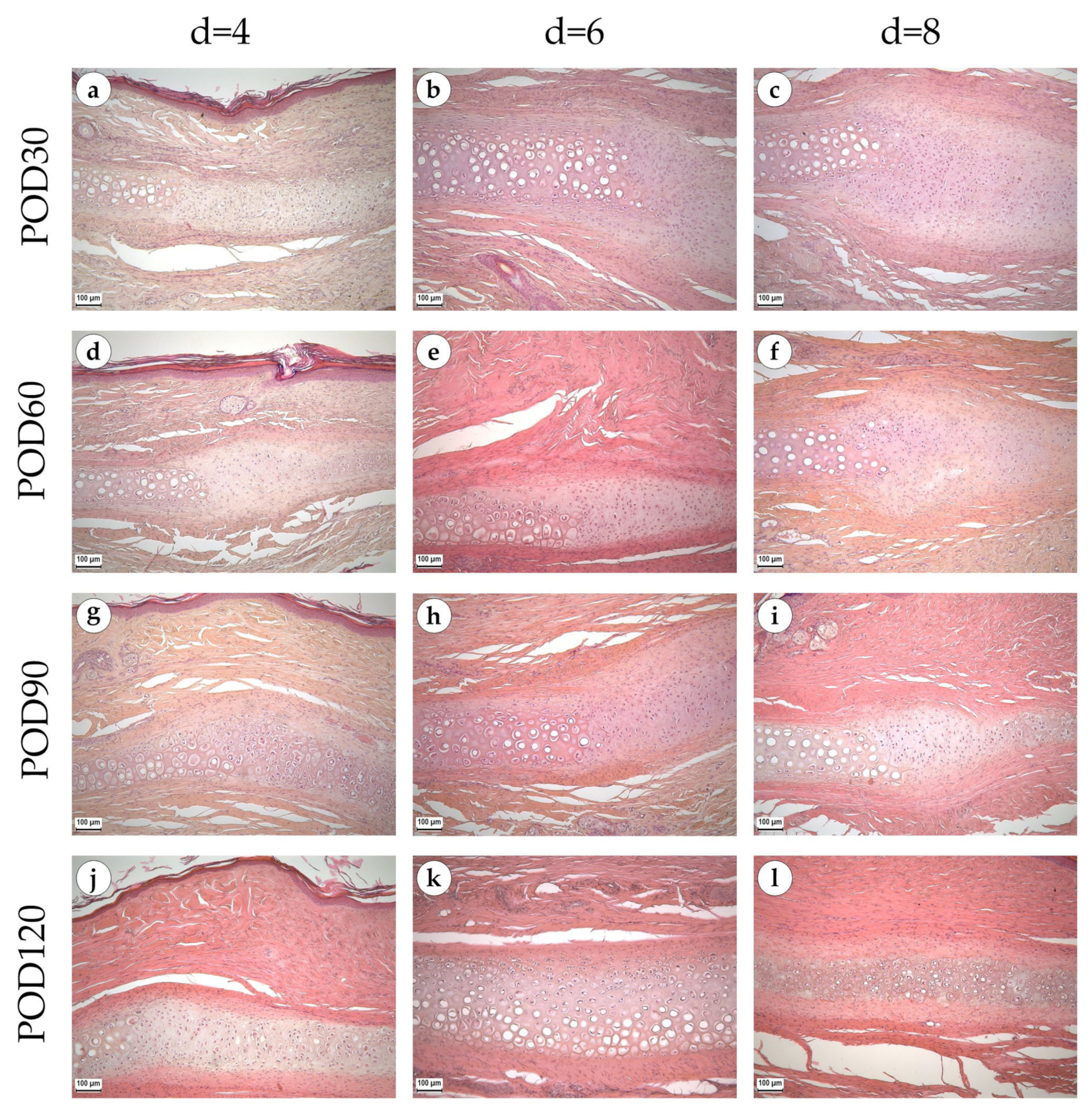
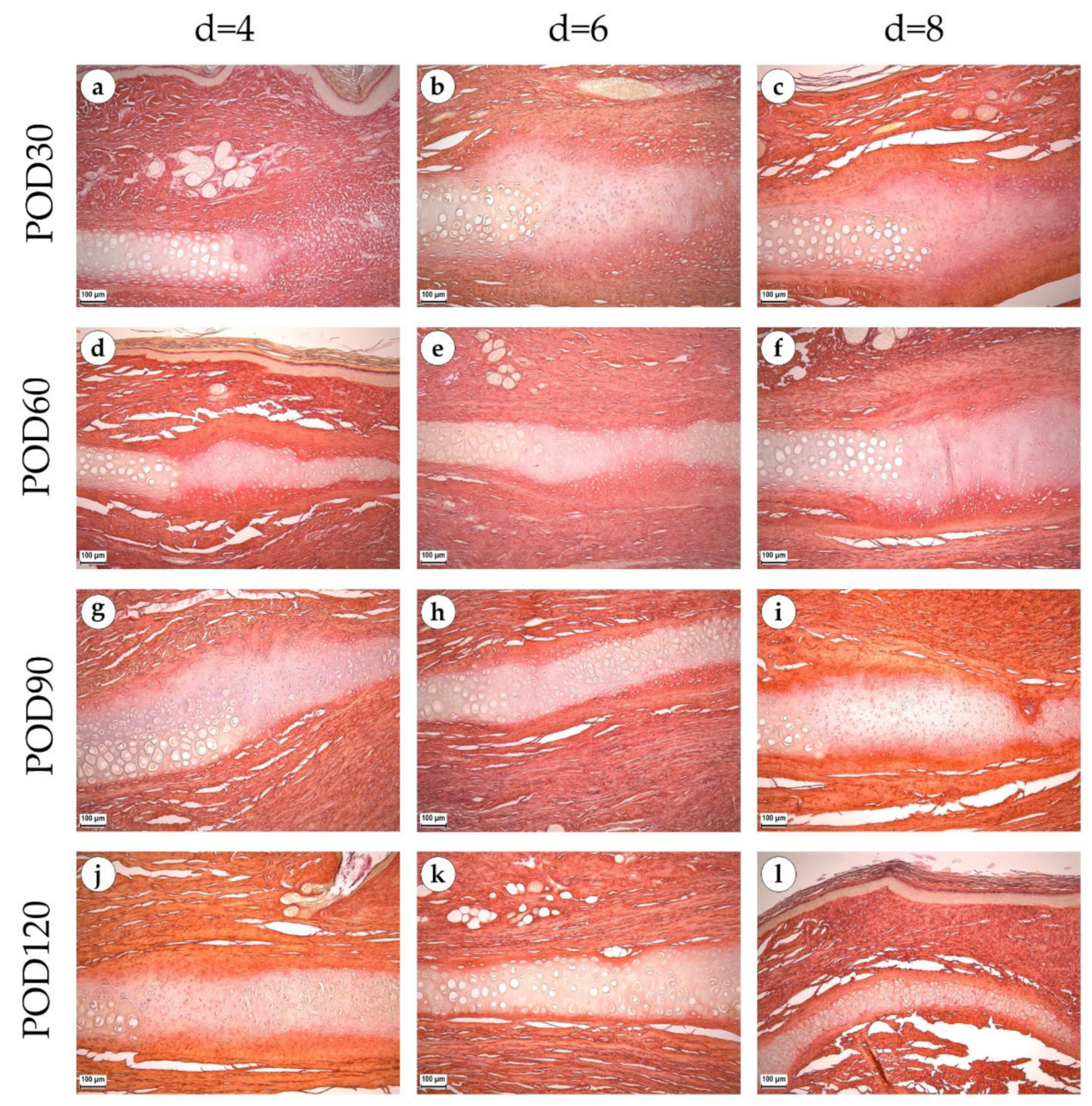
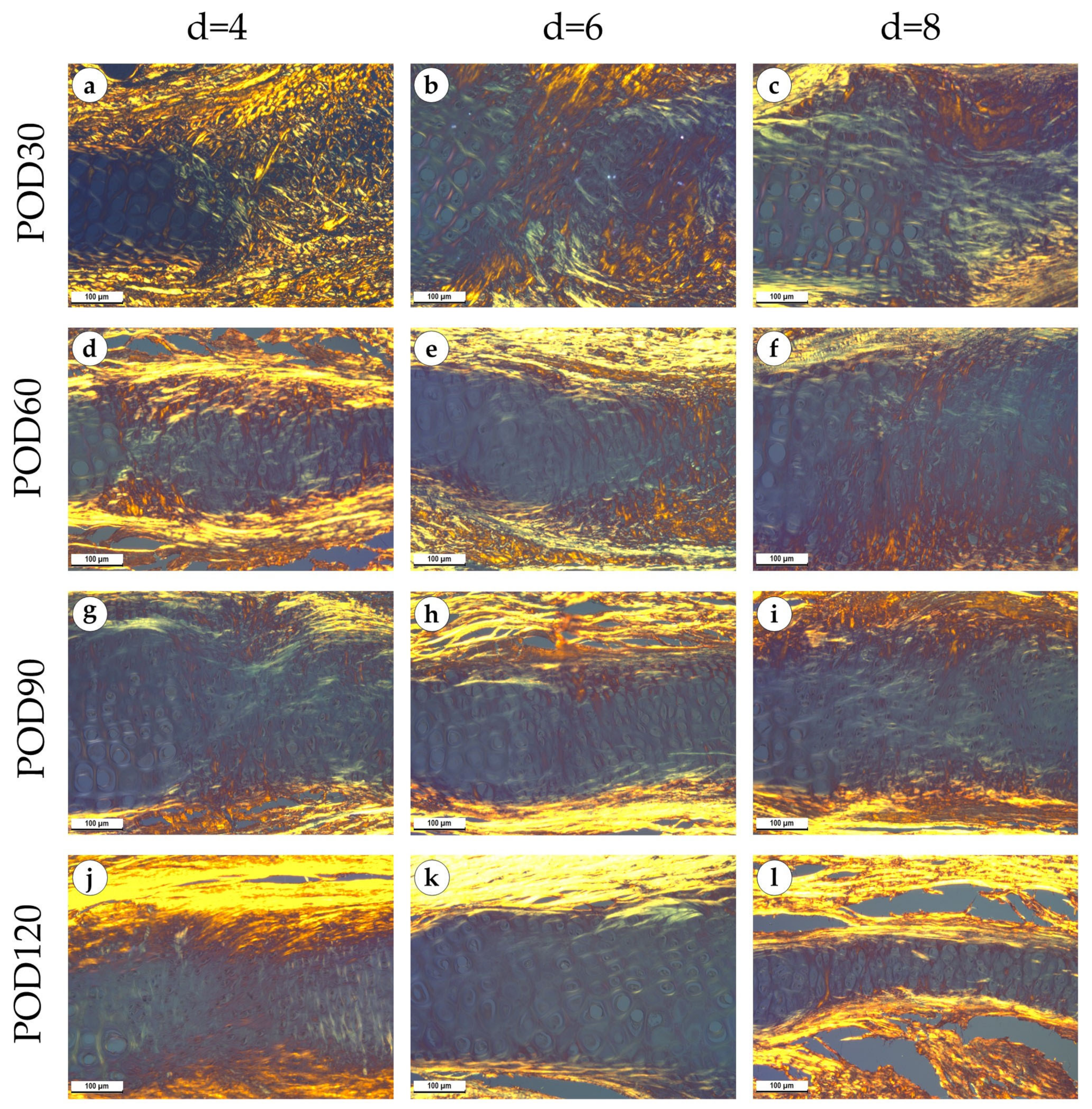

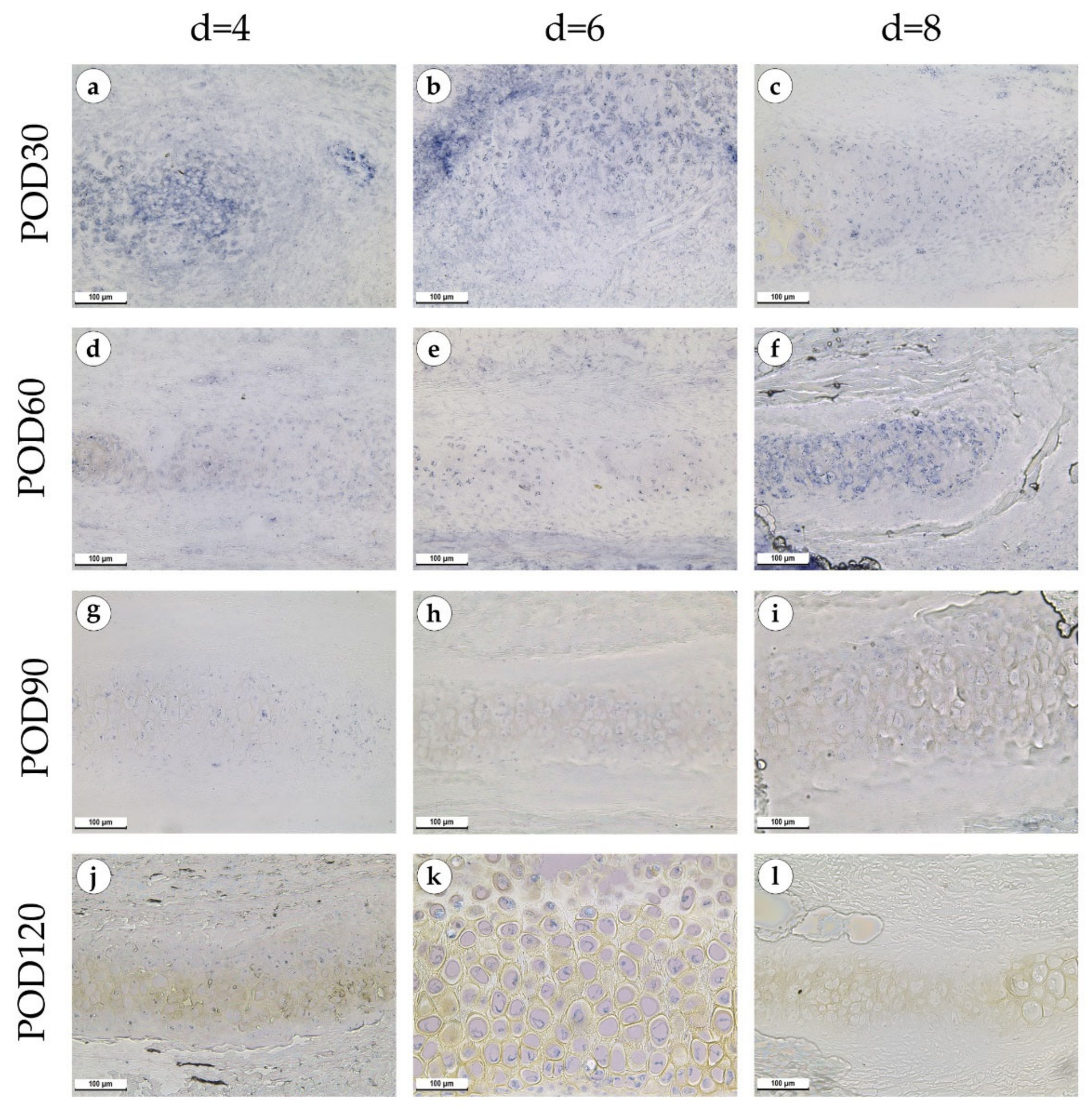
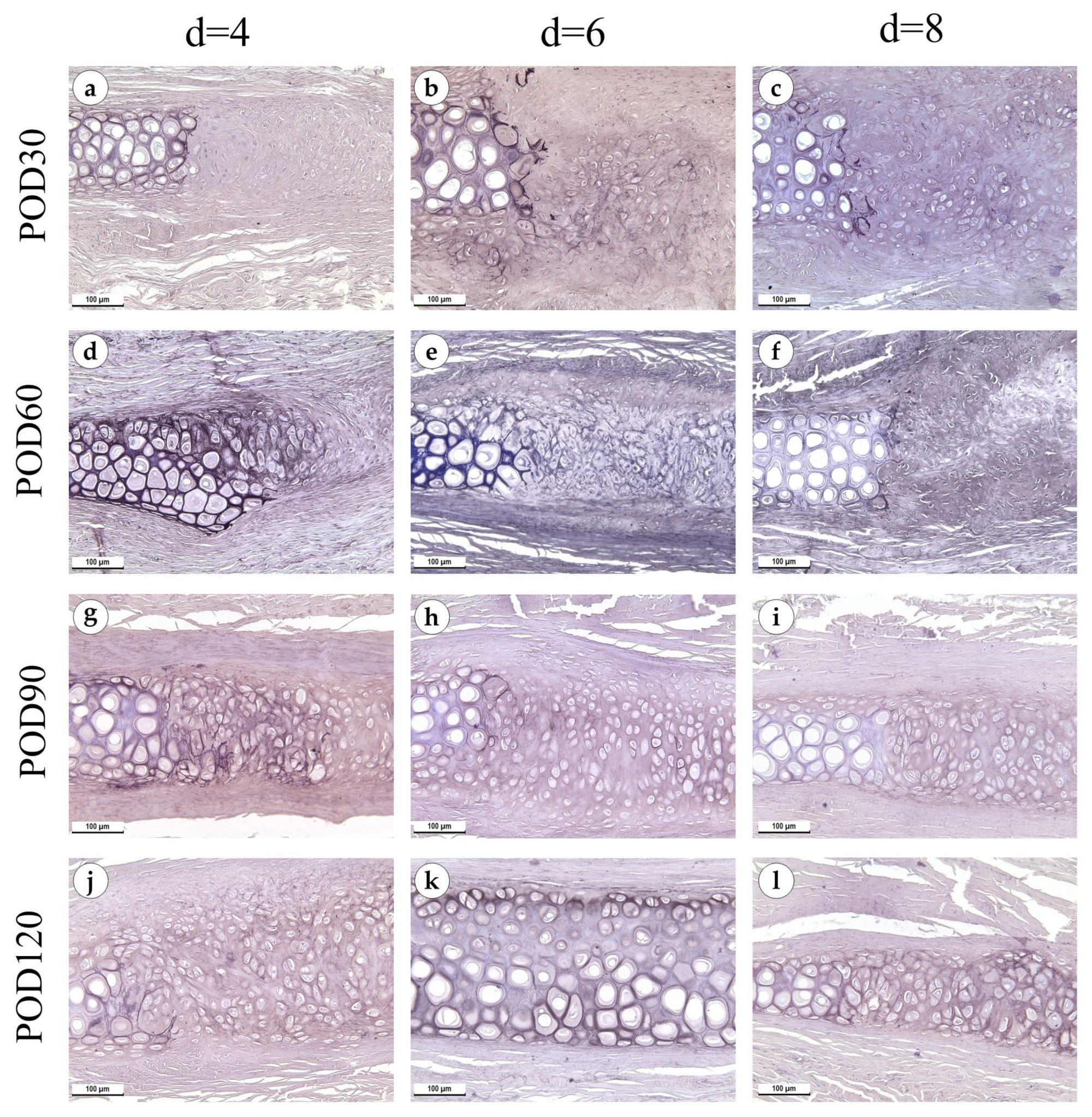





| Macroscopic Score | Wound Consolidation | Density | Wound Color | Surface Texture |
|---|---|---|---|---|
| 0 | Below 25% | Whole volume of the defect was dense | Red | Deformed with retractions and bulges |
| 1 | 25–50% | Wound edges were dense | Pale | Smooth and even |
| 2 | 50–75% | - | Pigmented | - |
| 3 | Above 75% | - | Normal | - |
| Epimorphic Regeneration Score | Morphological Features |
|---|---|
| 0 | Absence of round chondrocytes in regenerating fibrous cartilage |
| 1 | Presence of round chondrocytes in regenerating fibrous cartilage |
| 2 | Foci of regenerated elastic cartilage with large lacunae surrounded by elastic fibers |
| 3 | Continuous area of regenerated elastic cartilage with large lacunae surrounded by elastic fibers |
| Elastic Fiber Regeneration Score | Morphological Features |
|---|---|
| 0 | Absence of elastic fibers |
| 1 | Separate foci (islands) of elastic fibers |
| 2 | Elastic fibers are located close to resident cartilage plate margins |
| 3 | Regenerating cartilage plate with elastic fibers |
| SA-β-Galactosidase Score | Morphological Intensity Features | Morphological Cell Quantity Features |
|---|---|---|
| 0 | Absence of SA-β-galactosidase positive cells | |
| 1 | Up to one positive granule in a cell | Singular SA-β-galactosidase positive cells |
| 2 | Several (up to four) positive granules in a cell | Foci of SA-β-galactosidase positive cells |
| 3 | Positive staining of the major part of the cell | Majority of SA-β-galactosidase positive cells |
| RCA120 Score | Morphological Features |
|---|---|
| 0 | Absence of RCA120 positive cells |
| 1 | Up to one RCA120 positive cell in × 400 field of view |
| 2 | Two or more RCA120 positive cells located sparsely in × 400 field of view |
| 3 | Numerous RCA120 positive cells located in groups in × 400 field of view |
Disclaimer/Publisher’s Note: The statements, opinions and data contained in all publications are solely those of the individual author(s) and contributor(s) and not of MDPI and/or the editor(s). MDPI and/or the editor(s) disclaim responsibility for any injury to people or property resulting from any ideas, methods, instructions or products referred to in the content. |
© 2023 by the authors. Licensee MDPI, Basel, Switzerland. This article is an open access article distributed under the terms and conditions of the Creative Commons Attribution (CC BY) license (https://creativecommons.org/licenses/by/4.0/).
Share and Cite
Valieva, Y.; Igrunkova, A.; Fayzullin, A.; Serejnikova, N.; Kurkov, A.; Fayzullina, N.; Valishina, D.; Bakulina, A.; Timashev, P.; Shekhter, A. Epimorphic Regeneration of Elastic Cartilage: Morphological Study into the Role of Cellular Senescence. Biology 2023, 12, 565. https://doi.org/10.3390/biology12040565
Valieva Y, Igrunkova A, Fayzullin A, Serejnikova N, Kurkov A, Fayzullina N, Valishina D, Bakulina A, Timashev P, Shekhter A. Epimorphic Regeneration of Elastic Cartilage: Morphological Study into the Role of Cellular Senescence. Biology. 2023; 12(4):565. https://doi.org/10.3390/biology12040565
Chicago/Turabian StyleValieva, Yana, Aleksandra Igrunkova, Alexey Fayzullin, Natalia Serejnikova, Aleksandr Kurkov, Nafisa Fayzullina, Dina Valishina, Alesia Bakulina, Peter Timashev, and Anatoly Shekhter. 2023. "Epimorphic Regeneration of Elastic Cartilage: Morphological Study into the Role of Cellular Senescence" Biology 12, no. 4: 565. https://doi.org/10.3390/biology12040565
APA StyleValieva, Y., Igrunkova, A., Fayzullin, A., Serejnikova, N., Kurkov, A., Fayzullina, N., Valishina, D., Bakulina, A., Timashev, P., & Shekhter, A. (2023). Epimorphic Regeneration of Elastic Cartilage: Morphological Study into the Role of Cellular Senescence. Biology, 12(4), 565. https://doi.org/10.3390/biology12040565







